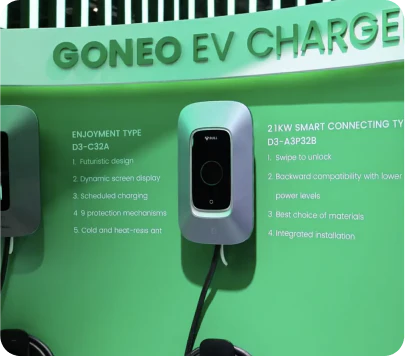As electric vehicles (EVs) continue to gain popularity, the demand for more convenient and efficient charging solutions is growing. While traditional plug-in EVSE (Electric Vehicle Supply Equipment) has been the industry standard, wireless charging technology is emerging as a game-changer. Companies like GONEO, known for their innovations in smart charging solutions, are investing in wireless EVSE systems that promise to revolutionize how EVs are charged.
In this article, we’ll explore how wireless EV charging works, its benefits, challenges, and how it could shape the future of EVSE.
1. How Wireless EV Charging Works
Wireless EV charging, also known as inductive charging, uses electromagnetic fields to transfer power between a charging pad on the ground and a receiver installed in the EV. Here’s how the process works:
- Power Transmission – A ground-based charging pad, connected to an electrical power source, generates an alternating electromagnetic field.
- Power Reception – The EV has a built-in receiver that captures the electromagnetic energy and converts it into electricity.
- Battery Charging – The electricity is then used to charge the EV’s battery, just like traditional plug-in chargers.
Unlike wired EVSE, which requires manual connection, wireless charging eliminates cables and connectors, making the process seamless and more user-friendly.
2. Benefits of Wireless Charging for EVSE2.1. Enhanced Convenience
One of the biggest advantages of wireless EVSE is the convenience it offers. Instead of plugging in a charging cable, drivers simply park their car over a charging pad, and charging begins automatically. This is particularly useful for:
- Urban areas with limited space (no need for bulky charging stations).
- Fleet vehicles and taxis that require frequent charging.
- Disabled or elderly drivers who may struggle with heavy charging cables.
GONEO is developing automated wireless EVSE solutions that integrate with smart parking systems, allowing EVs to charge effortlessly while parked.
2.2. Improved Safety and Durability
Traditional EVSE uses physical connectors that wear out over time, especially in extreme weather conditions. Wireless charging:
✅ Eliminates the risk of connector damage (no exposed cables).
✅ Reduces electric shock hazards (useful in wet environments).
✅ Minimizes trip hazards in busy locations.
With GONEO’s smart wireless EVSE systems, charging pads can automatically detect an EV’s presence and prevent unauthorized power transmission, further enhancing safety.
2.3. Seamless Integration with Autonomous Vehicles
As autonomous driving technology advances, EVs will need a fully automated charging system. Wireless EVSE allows self-driving vehicles to charge themselves without human intervention.
Imagine self-driving taxis that park at a charging station, recharge wirelessly, and continue operating without downtime. GONEO is already working on AI-powered EVSE solutions that will enable this future scenario.
2.4. Reduced Wear and Tear
Plugging and unplugging a charger every day can cause wear on both the charging cable and the vehicle’s charging port. Wireless EVSE:
✅ Reduces mechanical strain on charging components.
✅ Extends the lifespan of EV charging infrastructure.
✅ Requires less maintenance compared to traditional plug-in EVSE.
3. Challenges of Wireless EVSE
Despite its many benefits, wireless EVSE faces some challenges that must be addressed before mass adoption.
3.1. Energy Efficiency Concerns
Wireless charging currently has higher energy losses compared to wired charging. While modern inductive charging systems are improving efficiency, plug-in chargers are still more energy-efficient.
However, companies like GONEO are developing advanced coil designs and AI-powered optimization systems to improve wireless charging efficiency.
3.2. High Infrastructure Costs
Installing wireless EVSE requires:
🚧 Specialized charging pads embedded in roads or parking spaces.
🚧 Upgraded electrical grids to support higher energy demands.
🚧 Additional manufacturing costs for vehicles to include wireless charging receivers.
To address this, GONEO is researching modular wireless charging systems that can be easily integrated into existing EVSE networks, reducing deployment costs.
3.3. Charging Speed Limitations
Currently, wireless EVSE cannot match the ultra-fast charging speeds of DC fast chargers. While Level 2 wireless charging (7-11 kW) is comparable to home chargers, Level 3 wireless charging (50 kW+) is still in early development.
However, GONEO’s next-generation wireless EVSE aims to support high-power fast charging, bridging the gap between convenience and speed.
4. The Future of Wireless EVSE
Wireless EVSE is expected to play a major role in future smart cities. Here are some trends we can expect:
4.1. Dynamic Wireless Charging
🔹 EVs charging while driving on electrified roads.
🔹 Continuous power supply for electric buses and delivery trucks.
🔹 Reduced need for large battery capacities, lowering EV costs.
Several countries, including Germany and South Korea, are already testing dynamic wireless charging highways, and GONEO is exploring ways to integrate this technology into smart transportation networks.
4.2. Integration with Renewable Energy
Wireless EVSE could be paired with solar and wind energy storage systems, allowing for:
✅ Green, sustainable charging.
✅ Grid stability by optimizing energy distribution.
✅ Lower electricity costs through smart energy management.
GONEO is actively developing AI-powered charging management platforms that balance energy loads and integrate with solar power solutions.
4.3. Standardization and Global Adoption
As more automakers and governments recognize the potential of wireless EVSE, efforts are being made to standardize charging protocols. Once a universal wireless charging standard is established, mass adoption will accelerate.
5. Conclusion: Is Wireless EVSE the Future?
While wireless charging technology is still evolving, it is set to transform the EVSE industry by making charging more convenient, safer, and future-proof. Companies like GONEO are leading the way with smart wireless charging solutions that enhance efficiency and integrate with autonomous vehicles, renewable energy, and AI-driven charging networks

